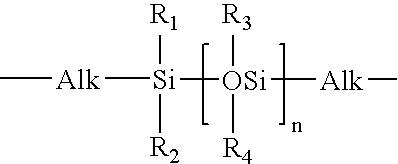Process for surface modifying substrates and modified substrates resulting therefrom
a technology of surface modification and substrate, which is applied in the field of surface modification substrate and modified substrate resulting therefrom, can solve the problems of exceptionally high oxygen permeability, plasma treatment processes, and significant capital investment in plasma processing equipment, and add to both capital and production costs
- Summary
- Abstract
- Description
- Claims
- Application Information
AI Technical Summary
Benefits of technology
Problems solved by technology
Method used
Image
Examples
examples
[0290]The present invention may be more readily understood by reference to the following Examples, without being limited thereto.
[0291]In the following examples, if not indicated otherwise, amounts are amounts by weight, temperatures are given in degrees Celsius. Tear break-up time values in general relate to the pre-lens tear film non-invasive break-up time (PLTF-NIBUT) that is determined following the procedure published by M. Guillon et al., Ophthal. Physiol. Opt. 9, 355-359 (1989) or M. Guillon et al., Optometry and Vision Science 74, 273-279 (1997). Average advancing and receding water contact angles of coated and non-coated lenses are determined with the dynamic Wilhelmy method using a Krüss K-12 instrument (Krüss GmbH, Hamburg, Germany). Wetting force on the solid is measured as the solid is immersed in or withdrawn from a liquid of known surface tension.
[0292]The molecular weight (“MW”) for the polymers utilized is set forth as an approximation. If no molecular weight is giv...
example a-1
Preparation of Aminofunctionalized Contact Lenses by Attaching a Tie Layer
[0293]a.) A 0.001M polyacrylic acid (PAA) solution (MW≈90,000) is prepared by adding 0.29 grams of a 25% aqueous PAA stock solution to 1000 ml of ultra-pure water in a beaker. Then the pH of the solution is adjusted to 2.5 by adding 1N HCl and the solution is filtered using qualitative filter paper.
[0294]b.) A 0.001 M polyallylamine hydrochloride (PAH) solution (MW≈50,000-65,000) is prepared by adding 0.09 g PAH (solid) into a small beaker; dissolving in ultra-pure (UP) water and transferring into a bigger beaker with a final volume of 1000 ml aqueous solution. The pH is then adjusted to 4.5 as measured with a pH meter. The solution is then filtered using qualitative filter paper.
[0295]c.) Swollen non-coated Lotrafilcon A lenses (polysiloxane / perfluoroalkyl polyether copolymer) in iso-propanol (IPA) are individually immersed into the solution a.) for 5 minutes. After this time, the lenses are withdrawn from th...
example a-2
Preparation of Aminofunctionalized Contact Lenses by Attachment of a Tie Layer
[0296]a.) A 0.1% by weight solution of a branched polyacrylic acid (Carbopol® 981 NF) is prepared by adding 0.05 g of Carbopol® 981 NF (BF Goodrich) to 50 ml of isopropanol-ultra-pure water mixture (1:4) in a beaker. After complete dissolution (overnight), the pH of the solution is adjusted to 2.5 by adding 1N HCl and the solution is filtered using qualitative filter paper.
[0297]b.) 100 ml of 0.05% solution of polyethyleneimine (PEI) is prepared by adding 0.1 g of 50% aqueous PEI stock solution into a mixture of isopropanol-ultra-pure water 1:4. The pH is then adjusted to 3.5 by adding 1N HCl as measured by pH meter. The solution is then filtered using qualitative filter paper.
[0298]c.) Swollen non-coated Lotrafilcon A lenses in iso-propanol (IPA) are individually immersed into the solution a.) for 10 minutes. The lenses are withdrawn from the solution a.) rinsed with ultra-pure water and immersed into the...
PUM
| Property | Measurement | Unit |
|---|---|---|
| mol % | aaaaa | aaaaa |
| mol % | aaaaa | aaaaa |
| mol % | aaaaa | aaaaa |
Abstract
Description
Claims
Application Information
 Login to View More
Login to View More - R&D
- Intellectual Property
- Life Sciences
- Materials
- Tech Scout
- Unparalleled Data Quality
- Higher Quality Content
- 60% Fewer Hallucinations
Browse by: Latest US Patents, China's latest patents, Technical Efficacy Thesaurus, Application Domain, Technology Topic, Popular Technical Reports.
© 2025 PatSnap. All rights reserved.Legal|Privacy policy|Modern Slavery Act Transparency Statement|Sitemap|About US| Contact US: help@patsnap.com



